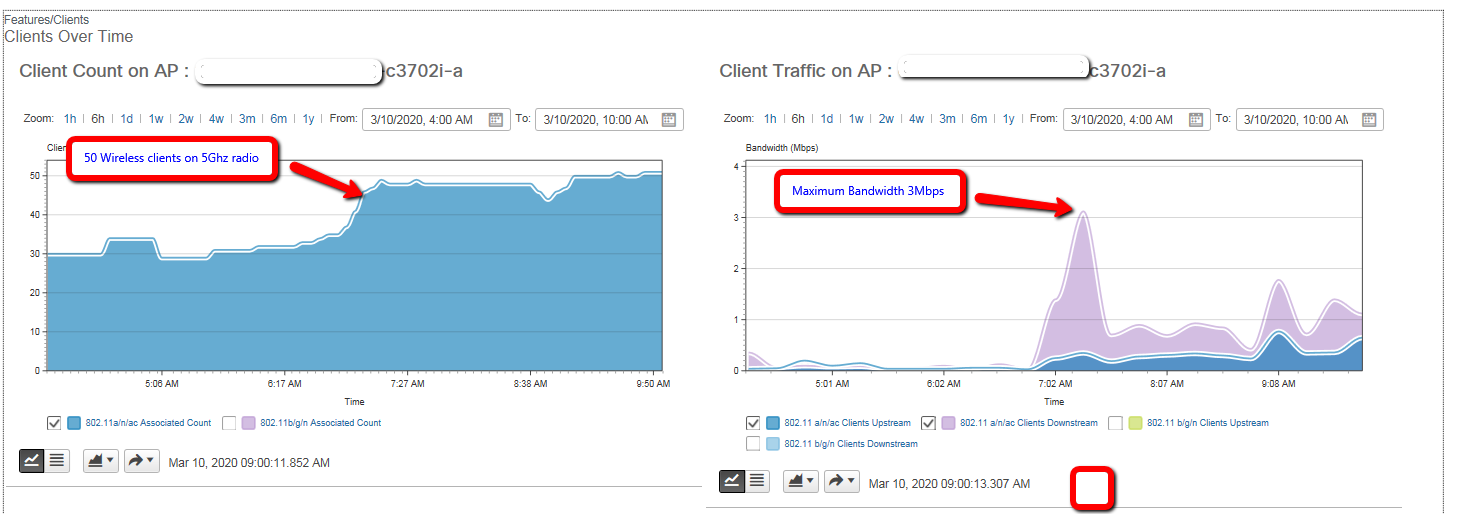During the wireless training and webinars, many of us learned the two critical root causes that could lead to performance degradation:
- A large number of wireless clients per radio (2.4Ghz or 5Ghz) – more than 20 clients per radio.
- High channel utilization – High data consumption by multiple wireless clients.
After many lab tests and production deployments, I have found two golden rules:
- Clients do not create the same amount of traffic at all times.
- A large number of clients does not leadto high channel utilization at all times.
Most of the time, we will experience poor performance and disconnections if radio channels are utilized more than 60% (for data services) or for more than 45% (for voice services).
In the screenshot below, we can see a high number of clients with a total bandwidth of 4Mbps. 
Channel utilization
As we can see, the same number of clients can utilize the radio channel differently during different times.

Solution for high channel utilization:
One of the most common solutions for high channel utilization is to increase the channel width from 20Mhz to 40, 80, or 160Mhz.
Potential issues we could experience after changing the channel width:
- Radio cell size may drop by ~7dB (when we change from 20Mhz to 40Mhz).
- We may create co-channel interference.
Channel width 20Mhz vs. 40Mhz

Reference material:
Radio Features impact on Wireless infrastructure and Wireless performance

Yes, you can lower channel utilization by going with wider channels. That is true. But you are also decreasing the number of available channels to choose from. (And lowering SNR by -3dB for each increase in channel width – you will listen to 2X more noise, thus lowering the SNR by -3dB)
And the biggest issue – you’ll most likely be increasing your collision domain. Fewer channels, means more chance of a channel already being used in the same area. Once you increase chances of CCI – you have more devices all sharing the same air time, thus increasing the chances of collisions, back-offs, and again increasing channel utilization – the very thing you were trying to get rid of in the first place.
Better is to stay with 20MHz channels, and increase the SPEED of each client’s connection, that also frees up airtime.
The thing we have LEAST of in Wi-Fi is Spectrum. Free up spectrum by more efficiently using what you have. That’s why I’m all about looking at the average MCS – increase MCS, lower Channel Utlliization – increase efficiency!
This comes down to your WLAN Design – you need to design around maximizing MCS for all clients in each cell. This may mean using directional antennas, almost assuredly means getting AP’s out of hallways, putting more money into the client devices – it isn’t all about the infrastructure you know.
Turn off lower data rates, don’t let legacy clients on your network, tons of things you can do to lower channel utilization…
Yes, you can lower channel utilization by going with wider channels. That is true. But you are also decreasing the number of available channels to choose from. (And lowering SNR by -3dB for each increase in channel width – you will listen to 2X more noise, thus lowering the SNR by -3dB)
And the biggest issue – you’ll most likely be increasing your collision domain. Fewer channels, means more chance of a channel already being used in the same area. Once you increase chances of CCI – you have more devices all sharing the same air time, thus increasing the chances of collisions, back-offs, and again increasing channel utilization – the very thing you were trying to get rid of in the first place.
Better is to stay with 20MHz channels, and increase the SPEED of each client’s connection, that also frees up airtime.
The thing we have LEAST of in Wi-Fi is Spectrum. Free up spectrum by more efficiently using what you have. That’s why I’m all about looking at the average MCS – increase MCS, lower Channel Utlliization – increase efficiency!
This comes down to your WLAN Design – you need to design around maximizing MCS for all clients in each cell. This may mean using directional antennas, almost assuredly means getting AP’s out of hallways, putting more money into the client devices – it isn’t all about the infrastructure you know.
Turn off lower data rates, don’t let legacy clients on your network, tons of things you can do to lower channel utilization…